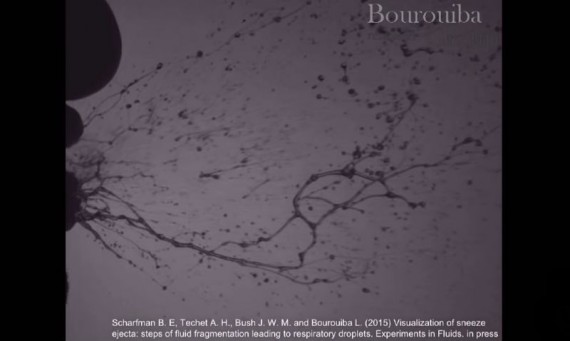Kath C. Eustaquio-Derla August 24, 2017 0
26 November 2015, 12:50 am EST
By Katherine Derla Tech Times
MIT researchers showed that sneeze droplets are not readily formed during escape from the mouth and nose. Sneeze droplets' formation involves a process that extends from sheets to bursts, to ligaments, and finally to droplets where viruses are trapped. ( Bourouiba Group, MIT )
Led by Dr. Lydia Bourouiba, researchers from the Massachusetts Institute of Technology revealed how a sneeze travels and spreads infection. For years, the research team has been analyzing the act of sneezing.
In early 2014, their initial research reveled in national attention when they released a high-speed imaging showing how far sneezes and cough can travel. For their recent study, the team captured on high-speed video how droplets form "within a high-propulsion sneeze cloud."
Contrary to what is assumed, droplets are not formed or neatly distributed straightaway when they escape the mouth through sneezes. Bourouiba's team videotaped two healthy adults who sneezed approximately 50 times in the span of a few days. Upon their analysis, they discovered droplets of several stages and sizes.
"You see droplets, but you also see that the break-up process continues to happen outside the respiratory tract. Even more surprisingly, you see a process that cascades from sheets, to bag bursts, to ligaments, and then the ligaments destabilize into droplets," said Bourouiba who calls the droplet formation as the "footprint of contamination."
The team's 2D analysis used only two cameras, one to capture the top view and one to capture the side view of the sneezes. However, during the assessment, the team realized that they needed to capture the three-dimensional dynamics of the sneezes.
Moving further, the team is currently using nine high-speed cameras to capture the 3D details of the sneeze cloud. The research's 2D analysis titled "Visualization of sneeze ejecta: steps of fluid fragmentation leading to respiratory droplets" is set to be released in the journal Experiment in Fluids soon.
Viruses, which are suspended in the droplets, can be inhaled or contacted by people unknowingly. This is how sneezes spread diseases such as SARS, influenza and measles upon contact with droplets suspended in the air.
The U.S. Centers for Disease Control and Prevention stressed the importance of sneezing and coughing etiquette to prevent the spread of infection transmitted via droplets. The U.S. agency recommends covering the nose and mouth with a tissue when sneezing or coughing. Proper disposal of used tissue and handwashing should be exercised. If tissue isn't readily available, sneezing or coughing directly into a handkerchief or sleeves is strongly advised.
The findings were presented during the American Physical Society's 68th Annual Meeting in Boston on Nov. 22 to 24. The research's abstract is available online in the American Physical Society's online bulletin.
By Katherine Derla Tech Times
MIT researchers showed that sneeze droplets are not readily formed during escape from the mouth and nose. Sneeze droplets' formation involves a process that extends from sheets to bursts, to ligaments, and finally to droplets where viruses are trapped. ( Bourouiba Group, MIT )
Led by Dr. Lydia Bourouiba, researchers from the Massachusetts Institute of Technology revealed how a sneeze travels and spreads infection. For years, the research team has been analyzing the act of sneezing.
In early 2014, their initial research reveled in national attention when they released a high-speed imaging showing how far sneezes and cough can travel. For their recent study, the team captured on high-speed video how droplets form "within a high-propulsion sneeze cloud."
Contrary to what is assumed, droplets are not formed or neatly distributed straightaway when they escape the mouth through sneezes. Bourouiba's team videotaped two healthy adults who sneezed approximately 50 times in the span of a few days. Upon their analysis, they discovered droplets of several stages and sizes.
"You see droplets, but you also see that the break-up process continues to happen outside the respiratory tract. Even more surprisingly, you see a process that cascades from sheets, to bag bursts, to ligaments, and then the ligaments destabilize into droplets," said Bourouiba who calls the droplet formation as the "footprint of contamination."
The team's 2D analysis used only two cameras, one to capture the top view and one to capture the side view of the sneezes. However, during the assessment, the team realized that they needed to capture the three-dimensional dynamics of the sneezes.
Moving further, the team is currently using nine high-speed cameras to capture the 3D details of the sneeze cloud. The research's 2D analysis titled "Visualization of sneeze ejecta: steps of fluid fragmentation leading to respiratory droplets" is set to be released in the journal Experiment in Fluids soon.
Viruses, which are suspended in the droplets, can be inhaled or contacted by people unknowingly. This is how sneezes spread diseases such as SARS, influenza and measles upon contact with droplets suspended in the air.
The U.S. Centers for Disease Control and Prevention stressed the importance of sneezing and coughing etiquette to prevent the spread of infection transmitted via droplets. The U.S. agency recommends covering the nose and mouth with a tissue when sneezing or coughing. Proper disposal of used tissue and handwashing should be exercised. If tissue isn't readily available, sneezing or coughing directly into a handkerchief or sleeves is strongly advised.
The findings were presented during the American Physical Society's 68th Annual Meeting in Boston on Nov. 22 to 24. The research's abstract is available online in the American Physical Society's online bulletin.









